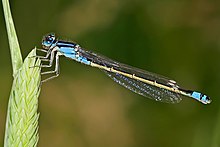Genus of damselflies
Ischnura damselflies known as forktails (or sometimes bluetails ) in the family Coenagrionidae .[ 2] [ 3]
Characteristics
Forktails are small or very small damselflies. The compound eyes of mature individuals have a dark upper region and contrasting lower part. The thorax is often green and may have lateral stripes and the abdomen in males is black with a blue tip. Females of some species are polymorphic , some being orangish and darkening with age, while others resemble the male.[ 3]
Species
The genus Ischnura includes the following species:[ 4] [ 5]
Ischnura abyssinica Martin, 1908 Ischnura acuticauda Lieftinck, 1959 Ischnura albistigma Fraser, 1927 Ischnura aralensis Haritonov, 1979 Ischnura ariel Lieftinck, 1949 Ischnura asiatica (Brauer, 1865) – Redtail[ 6] Ischnura aurora Brauer, 1865 – Aurora bluetail[ 6] Ischnura barberi Currie, 1903 – Desert forktail[ 7] Ischnura buxtoni Fraser, 1927 Ischnura capreolus (Hagen, 1861) Ischnura cardinalis Kimmins, 1929 Ischnura cervula Selys, 1876 – Pacific forktail[ 7] Ischnura chingaza Realpe, 2010 Ischnura chromostigma Fraser, 1927 Ischnura cruzi De Marmels, 1987 Ischnura cyane Realpe, 2010 Ischnura damula Calvert, 1902 – Plains forktail[ 8] Ischnura demorsa (Hagen, 1861) – Mexican forktail[ 8] Ischnura denticollis (Burmeister, 1839) – Black-fronted forktail[ 7] [ 9] Ischnura dorothea Fraser, 1924 Ischnura elegans (vanderLinden, 1823) – Blue-tailed damselfly[ 10] Ischnura erratica Calvert, 1895 – Swift forktail[ 7] Ischnura evansi Morton, 1919 – Blue-banded damsel[citation needed Ischnura ezoin (Asahina, 1952) Ischnura filosa Schmidt, 1951 Ischnura fluviatilis Selys, 1876 Ischnura forcipata Morton, 1907 Ischnura fountaineae Morton, 1905 – Oasis bluetail[ 11] Ischnura gemina (Kennedy, 1917) – San Francisco forktail[ 7] Ischnura genei (Rambur, 1842) – Island bluetail[ 11] Ischnura graellsii (Rambur, 1842) – Iberian bluetail[ 11] Ischnura haemastigma Fraser, 1927 Ischnura hastata (Say, 1839) – Citrine forktail[ 7] Ischnura heterosticta (Burmeister, 1839) – Common bluetail[ 6] Ischnura inarmata Calvert, 1898 Ischnura indivisa (Ris, 1918) Ischnura intermedia Dumont 1974 Ischnura isoetes Lieftinck, 1949 Ischnura karafutonis Matsumura, 1931 [citation needed Ischnura kellicotti Williamson, 1898 – Lilypad forktail[ 12] Ischnura luta Polhemus, Asquith & Miller, 2000 - Rota blue damselflyIschnura ordosi Bartenev, 1912 Ischnura pamelae Vick & Davies, 1988 Ischnura perparva Selys, 1876 – Western forktail[ 7] [ 12] Ischnura posita (Hagen, 1861) – Fragile forktail[ 9] [ 12] Ischnura prognata (Hagen, 1861) – Furtive forktail[ 12] Ischnura pruinescens (Tillyard, 1906) – Colourful bluetail[ 6] Ischnura pumilio (Charpentier, 1825) – Small bluetail or scarce blue-tailed damselfly[ 10] Ischnura ramburii (Selys, 1850) – Rambur's forktail[ 7] Ischnura rhodosoma Lieftinck, 1959 Ischnura rubella Navás, 1934 Ischnura rufostigma Selys, 1876 Ischnura rufovittata (Blanchard, 1843) Ischnura saharensis Aguesse, 1958 – Sahara bluetail[ 13] Ischnura sanguinostigma Fraser, 1953 Ischnura senegalensis (Rambur, 1842) – Marsh bluetail[ 14] Ischnura spinicauda Brauer, 1865 Ischnura stueberi Lieftinck, 1932 Ischnura taitensis Selys, 1876 Ischnura thelmae Lieftinck, 1966 Ischnura ultima Ris, 1908 †Ischnura velteni Bechly, 2000 [ 15]
Ischnura verticalis (Say, 1839) – Eastern forktail[ 9] [ 12] Ischnura vinsoni Fraser, 1949
References
Wikimedia Commons has media related to
Ischnura .
^ Charpentier, T. (1840). Libellulinae Europaeae Descriptae et Depictae hdl :2027/nyp.33433011575317 . ^ "Genus Ischnura Charpentier, 1840" . Australian Faunal Directory Australian Biological Resources Study . 2012. Retrieved 3 April 2017 .^ a b Paulson, Dennis (2009). Dragonflies and Damselflies of the West ISBN 978-1-4008-3294-1 ^ Paulson, D.; Schorr, M.; Abbott, J.; Bota-Sierra, C.; Deliry, C.; Dijkstra, K.-D.; Lozano, F. (2024). "World Odonata List" . OdonataCentral, University of Alabama . ^ "Odonata species list" . Swedish Museum of Natural History . Archived from the original on 17 January 2011. Retrieved 11 August 2010 .^ a b c d Günther Theischinger; John Hawking (2006). The complete field guide to dragonflies of Australia . CSIRO Publishing. ISBN 0-643-09073-8 ^ a b c d e f g h "California Damselflies" . Dragonflies (Odonata) of the Southwest . Archived from the original on 2009-09-23.^ a b "Species List: Damselflies" . azdragonfly.net . Archived from the original on 2011-07-21. Retrieved 2010-08-13 .^ a b c Abbott, John (2008). Dragonflies and Damselflies (Odonata) of Texas, Vol 3 . Odonata Survey of Texas. ISBN 978-0-615-19494-3 ^ a b "Checklist of UK Species" . British Dragonfly Society . Retrieved 5 August 2010 .^ a b c "Checklist, English common names" . DragonflyPix.com. Archived from the original on 4 December 2012. Retrieved 5 August 2010 .^ a b c d e "North American Odonata" . University of Puget Sound. 2009. Retrieved 5 August 2010 .^ Samraoui, B. & Dijkstra, K.-D.B. (2010). "Ischnura saharensis " . IUCN Red List of Threatened Species 2010 : e.T165477A6031236. doi :10.2305/IUCN.UK.2010-3.RLTS.T165477A6031236.en . Retrieved 24 December 2017 . ^ Sharma, G.; Clausnitzer, V. (2016). "Ischnura senegalensis " . IUCN Red List of Threatened Species 2016 : e.T59897A75436136. doi :10.2305/IUCN.UK.2016-3.RLTS.T59897A75436136.en . Retrieved 15 November 2021 . ^ Toussaint, E. F. A.; Bybee, S. M.; Erickson, R. J.; Condamine, F. L. (8 February 2019). "Forest giants on different evolutionary branches: Ecomorphological convergence in helicopter damselflies". Evolution . 73 (5): 1045– 1054. doi :10.1111/evo.13695 . PMID 30734925 . S2CID 73426853 .
